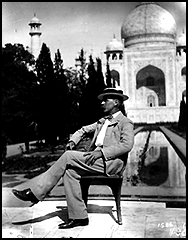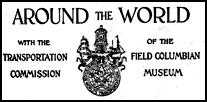Intro I.
William Henry Jackson was born in 1843 in Keeseville, New York, the son of a blacksmith. By the age of twelve he was selling drawings to neighbors. He fought at Gettysburg, and after the Civil War headed west. In 1870 he joined the Hayden Survey, named after the famous geographer and explorer Ferdinand Vandiveer Hayden. For the next eight years, in the words of historian Peter Hale, Jackson's photographs "revealed the essential qualities of the West and reproduced the experience of contact with wilderness and God for millions of viewers." |  |
| Jackson was the leading photographer of the American West in the 19th century. His photographs helped turn Yellowstone into the first national park. He was the first white man to see and photograph the Mesa Verde ruins of the Anasazi people in Colorado. After the Hayden Survey years, Jackson settled down to a successful commercial career in Denver. His pictures now revealed the steady conquest of the Frontier by the railroads. By the 1890's he was called "America's greatest landscape photographer."
|
 |
But he was not immune to the effects of the recession that began early that decade. There was also the question of a new frontier to explore, something even bigger than America. |
The popular World Columbian Exposition in Chicago in 1893 helped open America's eyes to the rest of the world. Jackson made the official set of views for the Exposition and befriended one of its organizers, Major Joseph Pangborn. After the Exposition, Pangborn offered Jackson a five-year, all expenses paid trip around the world. It seemed too good an offer to resist.
As it turned out, he was back in half the time and did his best work in India. Even so, at the age of fifty, barely half his life was over. Soon after his return, Jackson took his negatives to a new company, The Detroit Publishing Co. where he became critical to the Photochrom process and the color postcard revolution in America. When the company went down in 1924 because of its expensive trademark process, he became a successful commercial painter, writer and lecturer.
He lived and worked until he turned 99 in 1942, and is buried in Arlington National Cemetery. Among his many relatives is Bill William Henry Jackson Griffith, the creator of Zippy the Pinhead cartoons.
Jackson's reputation and skills were appreciated in India as well. At the end of his journey through the country in 1895, he presented two large panoramas in competition at the annual Calcutta Photographic Exhibit. One of them, a landscape shot of Ouray, Colorado, won a bronze medal.
Other introductory pages examine magic lantern slides, another early color process that resulted in Photochroms, and relevant books.
Commercial rights to these images are also available. |
| II. SLIDES
| III. PHOTOCHROMS
| IV. BOOKS | | | | |